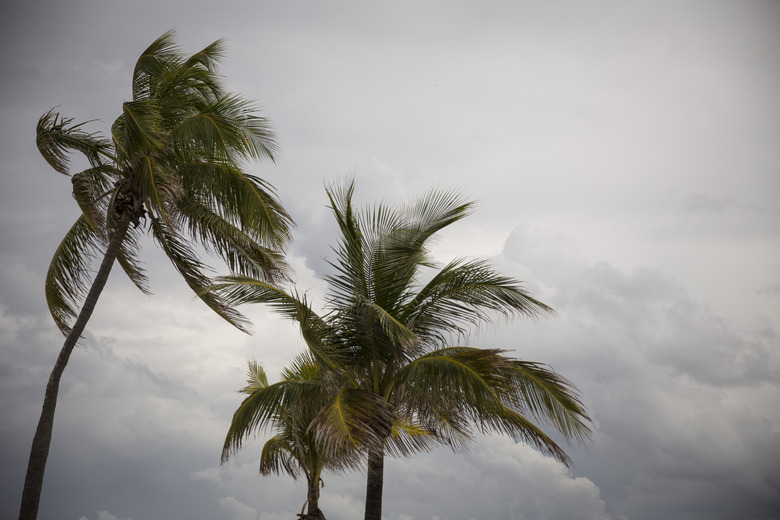What Are The Characteristics Of A Tropical Storm?
A tropical storm, otherwise known as a tropical cyclone, is a storm that originates in the ocean during the warmer seasons and is characterized by high, often destructive winds. A hurricane is also considered a type of tropical cyclone, but with much higher wind speeds. Because tropical storms occur when ocean water evaporates quickly, they always begin in an ocean and can move towards land once developed. Understanding the characteristics of a tropical cyclone begins with understanding how and why they form.
Development
Development
A tropical storm develops during the warm seasons when pressure from the evaporating seas is paired with cool air from the atmosphere. Combined with low and high pressures, the clouds begin to circulate and move from the surface of the sea into the atmosphere, creating the characteristic spiral shape of the tropical storm. Tropical storms can develop very quickly since evaporated water pushes wind to the surface of the ocean, speeding up evaporation and growth. Once the storm reaches wind speeds of 38 mph, the storm is officially named a tropical cyclone, according to the Caribbean Institute for Meteorology and Hydrology.
Seasons
Seasons
Tropical storms in the Atlantic Ocean generally occur between June and November but can still appear outside of these dates, according to the Atlantic Oceanographic and Meteorological Laboratory. The storms are most likely to happen during these times because warm summer air causes ocean water to evaporate and create clouds, and eventually as this process continues, the storm develops into a tropical cyclone. Because of this process, warmer areas near oceans are more likely to see tropical storms.
Winds
Winds
After the initial development of a tropical storm, wind speeds determine the severity and type of tropical storm. The most severe tropical storm can have winds up to 78 mph, according to the National Oceanic and Atmospheric Administration. The circulation of high and low pressures causes the high winds and wind speed to pick up quickly, often taking meteorologists by surprise. The rapid winds are known to be the most destructive part of tropical storms, although heavy rains and thunder can accompany the wind. A tropical storm is called a "cyclone" when it has wind speeds between 38 mph and 73 mph, and it is called a "hurricane" when the wind speeds exceed 73 mph.
Predictions
Predictions
Tropical storms are difficult to predict since they begin in the ocean, which is not monitored as heavily as land, and because there is confusion about the physics of the development of tropical storms. Weather organizations continue to research and observe areas susceptible to tropical storms in hopes of better preparing for possible dangers or damages, and reasons for the development of the storms are still debated among scientists.
References
Cite This Article
MLA
Wallace, Rachael. "What Are The Characteristics Of A Tropical Storm?" sciencing.com, https://www.sciencing.com/what-are-the-characteristics-of-a-tropical-storm-13419017/. 22 November 2019.
APA
Wallace, Rachael. (2019, November 22). What Are The Characteristics Of A Tropical Storm?. sciencing.com. Retrieved from https://www.sciencing.com/what-are-the-characteristics-of-a-tropical-storm-13419017/
Chicago
Wallace, Rachael. What Are The Characteristics Of A Tropical Storm? last modified March 24, 2022. https://www.sciencing.com/what-are-the-characteristics-of-a-tropical-storm-13419017/
